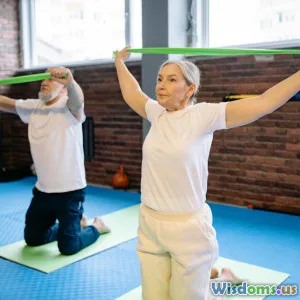
Why Flexibility Matters More As You Age
8 min read Discover why maintaining flexibility is crucial as we age and how it enhances quality of life, mobility, and health in older adults. (0 Reviews)
Why Flexibility Matters More As You Age
A simple stretch might seem trivial in youth, but as we cross into our later decades, flexibility takes on a much greater significance. Aging isn’t just a journey marked by wrinkles or gray hair; it brings a natural decline in muscular elasticity, joint range of motion, and balance. Without attention to flexibility, this decline can spiral into reduced independence, increased risk of falls, and chronic pain.
This article dives into why maintaining and improving flexibility is not just good advice but essential as we age. We’ll explore the physical changes aging inflicts on our bodies, unpack the critical benefits flexibility brings at older ages, and offer practical tips to cultivate and protect your mobility.
The Science of Aging: What Happens to Our Muscles and Joints?
Aging triggers a complex set of biological transformations in our musculoskeletal system. According to the National Institute on Aging, muscle mass and strength diminish roughly 3-8% per decade after age 30, a condition known as sarcopenia. But alongside muscle loss, there is a less obvious yet equally impactful decline in muscle elasticity and joint flexibility.
Stiffening Collagen and Joint Structures
Collagen, a protein matrix vital for tissue elasticity, decreases and stiffens with age. This affects tendons, ligaments, and cartilage, restricting joints’ range of motion. A 2016 study in the Journal of Aging Research highlights that older adults experience a 30–50% decrease in joint flexibility compared to younger adults.
Impact on Daily Activities
This reduced pliability means everyday movements, such as reaching overhead, bending to tie shoes, or turning the head while driving, become increasingly challenging and sometimes painful. Activities that require balance and quick reaction capabilities, such as navigating stairs or uneven surfaces, become riskier as flexibility declines.
Why Flexibility Takes On Greater Importance with Age
The natural loss of flexibility that occurs with aging makes maintaining— or even improving—flexibility vital to preserve quality of life. Here’s why:
1. Enhanced Mobility and Independence
Maintaining flexibility directly correlates with improved mobility. With better joint range of motion, older adults can perform essential tasks independently—from getting in and out of chairs to dressing themselves. A 2018 cohort study published in The Journals of Gerontology found seniors who actively maintained flexibility reported higher levels of functional independence.
2. Reduced Risk of Falls and Injuries
Falls are the leading cause of injury among adults over 65, accounting for over 3 million emergency room visits annually in the United States alone (CDC, 2020). Flexible muscles and joints improve balance and coordination, enabling faster adjustments to unexpected shifts in posture, thus reducing fall risk.
3. Pain Relief and Joint Health
Flexibility exercises promote synovial fluid circulation within joints, which nourishes cartilage and reduces stiffness. Individuals with arthritis, a common condition in older adults, can experience significant pain relief simply by engaging regularly in stretching routines. The Arthritis Foundation notes increased joint flexibility can lessen discomfort and enhance day-to-day movement.
4. Mental and Emotional Benefits
The benefits of flexibility are not just physical. Gentle stretching and movement can reduce stress and improve mood by stimulating the parasympathetic nervous system. Practices such as yoga—a flexibility-centric exercise—also enhance mindfulness, helping to combat anxiety and depression common in aging populations.
Effective Strategies to Maintain and Improve Flexibility
Flexibility is not a fixed trait; it can be regained and even improved with targeted effort. Here are practical ways to integrate flexibility training into a routine, regardless of age:
Static Stretching
Static stretches involve holding a muscle in a lengthened position for 20-60 seconds. For older adults, consistent static stretching post-exercise alleviates muscle tightness. Examples include hamstring stretches or triceps stretches performed daily.
Dynamic Stretching
This comprises controlled, gentle movements that gradually increase reach and speed of motion, ideal as a warm-up routine. Arm circles, leg swings, and torso twists prepare muscles and joints for activity.
Yoga and Tai Chi
Both incorporate flexibility through slow, deliberate movements combined with balance and breathing techniques. Research published in the Journal of Alternative and Complementary Medicine found that older adults practicing yoga 2-3 times weekly for 12 weeks showed significant improvements in flexibility, balance, and fall prevention.
Pilates
Pilates focuses on core strength and spinal alignment, promoting flexibility especially in the back and hip flexors, areas prone to tightness with age.
Consistency and Gradual Progression
The American College of Sports Medicine recommends flexibility training at least two to three days per week, aiming for all major muscle groups. Progress should be gradual—pushing beyond comfort zones gently.
Real-World Insights: Stories of Transformation
Take the story of Grace, a 72-year-old retiree who suffered hip stiffness and limited mobility after years of sedentary office work. After joining a community yoga class twice weekly, she credits her regained flexibility for returning to hiking, gardening, and even dancing—activities she thought she had lost for good.
Or look at John, 68, who was able to avoid knee replacement surgery through a prescribed daily flexibility and strengthening routine focusing on knee joint mobility and quadriceps stretching.
These examples are not outliers but increasingly common narratives that highlight flexibility’s transformative power.
Conclusion: Flexibility Is Your Aging Superpower
Aging is inevitable, but decline in function is not. Among all facets of physical fitness, flexibility stands out as an often neglected but immensely beneficial component. It preserves independence, prevents injuries, relieves chronic pain, and fosters emotional well-being.
By understanding the biological reality of aging, you can proactively adopt routines that maintain or enhance flexibility—transforming how you age. Whether through targeted stretching, yoga, Tai Chi, or daily mindful movement, dedicated flexibility work pays dividends in mobility and quality of life.
Start today: it is never too late to stretch your way to a stronger, more graceful, and fulfilling later life.
References:
- National Institute on Aging
- Centers for Disease Control and Prevention (CDC)
- Journal of Aging Research, 2016
- The Journals of Gerontology, 2018
- Arthritis Foundation
- Journal of Alternative and Complementary Medicine
- American College of Sports Medicine
Rate the Post
User Reviews
Popular Posts



















